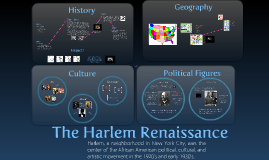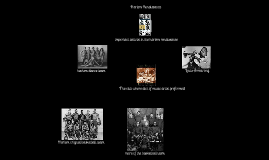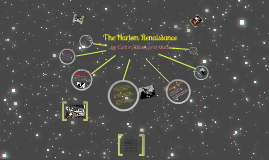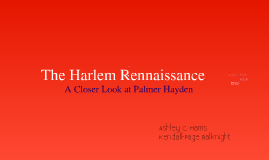Harlem Renaissance
Transcript: The Harlem Renaissance Harlem, a neighborhood in New York City, was the center of the African American political, cultural, and artistic movement in the 1920's and early 1930's. "Take The A Train" You must take the A train To go to Sugar Hill way up in Harlem If you miss the A train You'll find you missed the quickest way to Harlem Hurry, get on, now it's coming Listen to those rails a-humming All aboard, get on the A train Soon you will be on Sugar Hill in Harlem Geography You know, New York City: bright lights, big city; the big apple -- take a look! New York City is made up of 5 buroughs (think like Denver, Englewood, Aurora, etc.). Brooklyn Queens The Bronx Staten Island Manhattan When you think about New York City, you most likely are thinking about Manhattan Located on the far north side of Manhattan, Harlem is the birthplace of the Harlem Renaissance History 1865 13th Amendment Freedom for all slaves! Slavery is officially abolished. 1876 Jim Crow Laws The Jim Crow Laws are established throughout the South. The laws legalize and encourage segregation. 1890 - 1920 The Great Migration Between 1890 and 1920, over two million African Americans migrate from the rural South to the industrial North, in hopes of a better life with less discrimination. The largest migration in American history was caused by the 'push' of hardships prevalent in the South–such as segregation, lynching and the economic hopelessness of the sharecropping system–and the 'pull' of opportunity in the North. Plentiful industrial jobs, although sometimes menial, often offered wages three times higher than did jobs in the South. Glowing reports from friends and family already in the North inspired increased migration. While racism, housing shortages and crime often greeted the new arrivals, they also found organizations such as the National Urban League and National Association for the Advancement of Colored People (NAACP) dedicated to improving the lives of black Americans. 1910 NAACP sets up National Office in NYC The NAACP established its national office in New York City in 1910 and began publishing the official journal of the NAACP, The Crisis. 1917 United Negro Improvement Association Marcus Garvey, a Jamaican native, founds the United Negro Improvement Association, an organization that urges blacks to form their own nation. Impact? A growing African American middle class developed as a result of improved educational and employment opportunities for African Americans. Political Figures Founded NAACP National Association for the Advancement of Colored People Authored Several Books The Philidelphia Negro (1899) The Souls of Black Folk (1903) Black Reconstruction (1835) Black Folk, Then & Now (1939) "One ever feels his two-ness,--an American, a Negro; two souls, two thoughts, two unreconciled strivings; two warring ideals in one dark body, whose dogged strength alone keeps it from being torn asunder" "Either America will destroy ignorance or ignorance will destroy the United States." Believed that artistic and literary work could be used as a form of propaganda to help combat racial stereotypes and gain new respect for the race Advocated for the "talented tenth" This was the idea that a small percentage of the African American population who were exceptionally skilled should be designated and educated as artistic and cultural leaders. He proposed absolute equality for the "talented tenth" and technical training for the black masses. Founded UNIA Universal Negro Improvement Association "Unite all people of African ancestry of the world to one great body to establish a country and absolute government of their own. " Advocated for the "Back to Africa" movement Because of widespread racism and violence toward African Americans, Garvey believed that the only true solution to the problems was to reclaim their African heritage and go back to their homeland. The intent of the movement was for those of African ancestry to "redeem" Africa and for the European colonial powers to leave it. Culture Hughes was the first African American author to support himself through his writing; he produced more than sixty books. He earned critical attention for his portrayal of realistic black characters and he became one of the dominant voices speaking out on issues concerning black culture. He wrote in many genres; starting and continuing with poetry, he turned to fiction, autobiographies, and children's books. His most famous fictional character is Jesse B. Semple, nicknamed Simple, who uses humor to protest and satirize the existing injustices. "We Negro writers, just by being black, have been on the blacklist all our lives. Censorship for us begins at the color line." "I swear to the Lord, I still can't see, why Democracy means, everybody but me." 've known rivers: I've known rivers ancient as the world and older than the flow of human blood in human veins. My soul has grown deep like the rivers. I bathed in the Euphrates when dawns were young. I built my

















